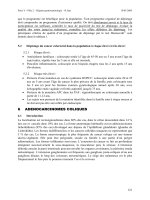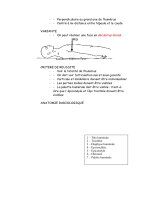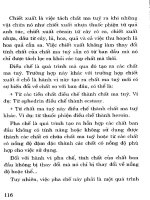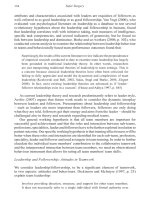Ear Surgery - part 5 potx
Bạn đang xem bản rút gọn của tài liệu. Xem và tải ngay bản đầy đủ của tài liệu tại đây (837.85 KB, 13 trang )
tive MRI but with no evidence of bone erosion on CT
scanning, then surgical exploration should be with-
held and the patients only followed with clinical and
radiologic methods to detect the possibility of a pro-
gressive lesion. Documentation of progression justies
surgical exploration.
5.2.3 Petrositis
In the preantibiotic era, the most common cystic lesion
of the petrous apex was infection, either chronic or
acute, as a result of extension of the inammatory
process from the middle ear and mastoid compart-
ments [11]. Progression of an epidural abscess in
Fig. 5.4 A CT scan in a middle-aged woman with recurrent
vertigo revealed an osteolytic lesion (arrowhead) in the petrous
apex
. Fig. 5.5 Arteriogram in the same patient as Fig 5.4 demon-
strated an aneurysm of the internal carotid artery. Since neuro-
logical decits were absent, observation was recommended. MC
middle cerebral artery
.
Fig. 5.6 Coronal MRI demonstrates a localized enhancement
(arrowhead) in the petrous apex of a middle-aged female with
recurrent vertigo and normal labyrinthine function
. Fig. 5.7 Axial CT scan demonstrated a cavity with intact
bone trabeculae in the petrous apex (arrowhead). Transmastoid
exploration revealed a venous lake
.
5
Chapter • Petrous Apex Lesions
the air cell system of the petrous apex, resulting in
bone destruction with dural irritation and involve-
ment of the cranial nerves adjacent to the petrous
apex represent Gradenigo’s syndrome (Figs. 5.8, 5.9).
e advent of antibiotics and thorough mastoid sur-
gery has virtually eliminated this complication of sup-
purative otitis media. Nevertheless, this complication
does occasionally occur and presents a similar constel-
lation of cranial nerve decits and symptoms (pain)
associated with signs of infection. Surgical exentera-
tion and drainage of the epidural petrous apex abscess
cavity is urgently indicated. Wide-eld mastoid and
middle ear exploration with identication of the cell
tract leading to the apex is necessary to correctly lo-
cate and manage the abscess cavity. Most frequently,
this tract will be located in the infra- or perilabyrin-
thine cell groups (posteromedial, posterosuperior).
e extent of bone removal required to expose the
cavity will depend on the presence or absence of func-
tion in the involved ear. If labyrinthine function is nor-
mal, then exenteration of the diseased air cells should
be performed with preservation of the otic capsule.
Insertion of drainage tube for the instillation of antibi-
otics into the abscess cavity is recommended for com-
plete treatment of the infected cavity. Resolution of
the inammatory process results in obliteration of the
defect with brous and osseous tissue. If labyrinthine
function is signicantly depressed, then a transcoch-
lear translabyrinthine approach to the petrous apex
abscess is chosen [7, 8].
Fig. 5.8 a Patient with chronic
otitis media and retro-orbital
pain. Axial CT scan demonstrates
opacication of petrous apex air
cells with decalcication of bony
trabeculae (arro w). The contral-
ateral petrous apex is normal.
b Coronal CT of same patient
shows erosion of the carotid canal
(arrow) and air in the Eustachian
tube (arrowhead)
.
. Management
5.2.4 Congenital Epidermoid Cyst
Although the petrous apex may be invaded by exten-
sion of acquired cholesteatoma arising in the middle
ear, a congenital epidermoid cyst limited to the petrous
apex is a cystic lesion caused by retention of epithelial
remnants embryonically in the region of the foramen
lacerum [2, 8]. e cartilage in this space is a remnant
of the embryonic mesenchyme in the cephalic ex-
ure, which may entrap epithelial remnants from the
foregut as they recede before the shrinking cephalic
exure during development. e pattern of growth
and clinical symptoms are similar to that of the pro-
gressive petrous apex lesions. Congenital epidermoid
cysts of the petrous apex usually become manifest in
young adulthood or early middle age [2, 13]. At this
point the epidermoid has reached a size where sur-
rounding structures are aected, and signicant bone
loss permits identication with modern CT and MRI
techniques. e expanding pattern of bone erosion
typical of a congenital cystic lesion is demonstrated
best with CT scanning (Fig. 5.10). An MRI study show-
ing a low-to-medium signal intensity on the T
1
image
and high signal intensity on the T
2
image is charac-
teristic of an epidermoid cyst [16] (Fig. 5.11). Because
of the progressive pressure exerted by retained kera-
Fig. 5.9 Horizontal temporal
bone specimen illustrates the his-
topathology of a petrous apicitis
(arrow). C internal carotid artery,
ET Eustachian tube
.
Fig. 5.10 Coronal CT scan of a
primary epidermoid in the petrous
apex (arrow)
.
5
Chapter • Petrous Apex Lesions
tin within a stratied squamous epithelial cyst wall,
compression of the cranial nerves and vascular and
ventilatory structures of the temporal bone eventu-
ally requires surgical treatment of this epidural tumor.
Since removal of the stratied squamous epithelial lin-
ing from the surrounding structures (internal carotid
artery, dura, jugular bulb, cranial nerves) is not pos-
sible without signicant morbidity, the recommended
management is decompression and exteriorization of
the epidermoid cyst [7, 8, 13, 14]. e surgical con-
siderations of this maneuver are essentially the same
as with other nonvascular cystic lesions of the petrous
apex such as cholesterol cyst (granuloma). erefore,
the technical considerations will be discussed together
with management of cholesterol cysts or granuloma of
the petrous apex.
Extension of cholesteatoma toward the petrous
apex through perilabyrinthine cell tracts or through
the labyrinth is managed by surgical removal of the
cholesteatoma membrane aer wide exposure of the
extension through an open mastoidectomy approach.
e epithelial membrane responsible for congenital
cholesteatoma (epidermoid) cysts of the petrous apex,
however, is rmly adherent to the dura, internal carotid
artery, and nerve bundles, requiring an extraordinary
surgical exposure associated with signicant morbid-
ity. It is questionable whether this membrane can be
completely excised in order to safely permit a closed
technique for repair (obliteration) [5]. However, it has
been suggested that once a congenital epidermoid cyst
has been evacuated, it may require 10–20 years for suf-
cient reaccumulation to produce clinical symptoms
[10]. Nevertheless, the technique of decompression
and exteriorization is favored because it has proven
to carry low morbidity and mortality while restricting
enlargement of the cyst [7, 8, 14]. ere is evidence
that such decompression leads to decrease in cyst size
[7] (Figs. 5.12, 5.13).
5.2.5 Cholesterol Granuloma
(Mucocele, Cholesterol Cyst)
Cholesterol granuloma is the most common cystic
lesion of the petrous apex and represents the end re-
sult of complete obstruction of an air cell tract to the
Fig. 5.11 MRI demonstrates enhancing cystic lesion of the
petrous apex consistent with primary epidermoid (arrow)
. Fig. 5.12 Base of skull x-ray demonstrates a large cystic lesion
of the petrous apex (a rrow), with compression of the Eustachian
tube and V
3
nerve in the foramen ovale (arrowhead)
.
Fig. 5.13 Six months after transmastoid stulization of the
cyst, recalcication of bone around the foramen ovale can be
seen (arrow)
.
. Management
petrous apex early in life [3]. e contralateral petrous
apex in patients with cholesterol cysts of the petrous
apex is usually well pneumatized, suggesting that the
involved petrous apex was similarly pneumatized early
in development. MRI characteristically demonstrates a
high signal lesion on both T
1
and T
2
images (Fig. 5.14).
A brous and bony obliteration occurs in a narrow
cell tract, which provides the pneumatization to the
apex [3]. Complete obstruction leads to the sequence
of events that is responsible for mucocele formation
in aerated compartments of the paranasal sinuses as
well as in the temporal bone [4, 6, 12]. Resorption of
the normal gas component leads to obliteration of the
space with mucoid uid and breakdown products of
blood from the capillary network of the mucoperio-
steal lining. e breakdown products of hemoglobin
(hemosiderin, cholesterol) eventually produce a for-
eign body reaction with macrophage accumulation,
giant cells, and the distribution of cholesterol crystals
within the so tissue lining of the cyst. e continued
accumulation of uid is responsible for progressively
increased pressure on the bony walls of the space, re-
sulting in breakdown of bone composition and com-
pression of the adjacent so tissue structures (Fig.
5.15). is lesion has been referred to in various terms
that reect either the mechanisms of the lesion or the
various stages of reaction to the obstruction. Mucocele,
cholesterol granuloma, and cholesterol cyst have been
used synonymously for this lesion. Since this lesion
has been documented with increased frequency by the
new imaging techniques, it is surprising that it was not
described in early literature. Petrous apex cystic le-
sions tting this description were reported in 1975 [7]
and 1979 [3], although the true nature of pathogenesis
was not appreciated. e 1979 report described a cystic
petrous apex lesion demonstrated by polytomography
in a young man that was shown at surgery to be a mu-
cocele. It was suggested that this lesion resulted from
an obstructed air cell tract in the petrous apex since
the contralateral petrous apex was well pneumatized.
Since it is unlikely that this is a new form of pathol-
ogy in the petrous apex, it is reasonable to assume that
it has been overlooked in the past, eluding diagnosis
and treatment. Radiologic techniques prior to the
modern era of temporal bone imaging failed to detect
bone erosion in the petrous apex unless it reached ex-
tensive proportions. e fate of patients with undiag-
nosed congenital epidermoids or cholesterol cysts of
the petrous apex can only be guessed. It is possible that
untreated progressive enlargement of these lesions re-
sulted in a defect of thinned dura, with communica-
tion into the adjoining intracranial space at the base of
the skull. Leakage of the cyst contents could produce a
chemical and/or bacterial meningitis and unexplained
death. e temporal bone and the paranasal sinuses
are oen overlooked in routine postmortem examina-
tion of such cases unless that portion of the skull is
examined carefully aer brain removal. is scenario
is suggested in the report of Caneld [1] describing
a young man with a chronically retracted tympanic
membrane, several episodes of unexplained coma,
somnolence, and fatal meningitis. Despite drainage
and treatment of the meningitis, the patient died and
postmortem examination revealed a large cystic space
Fig. 5.14 Typical appearance on MRI of a petrous apex cho-
lesterol cyst (arrow)
.
Fig. 5.15 Axial CT of the petrous apex shows an osteolytic
expanding lesion with dural exposure (arrows). Note pneuma-
tization of contralateral petrous apex with narrow cell tract
(arrowhead) to the middle ear
.
5
Chapter • Petrous Apex Lesions
in the petrous apex with a dural defect near the mid-
dle fossa.
erefore, decompression and permanent exte-
riorization is recommended for cystic lesions in the
petrous apex region that manifest progression by: (1)
bone erosion and exposed dura, (2) unresolved or
recurrent cranial nerve decits, and (3) persistent or
recurrent headache. e justication for surgical de-
compression is the prevention of a lethal complication
into the subarachnoid space. If the cystic lesion dem-
onstrates bone erosion short of dural exposure, then
observation with monitoring by CT scan periodically
(every 1 to 2 years) is permissible.
e technique of stulization of the cystic lesion
in the petrous apex depends on: (1) pneumatization
of the temporal bone and surrounding pneumatized
structures such as the sphenoid sinus, (2) the function
of the labyrinth in the involved and uninvolved ears,
and (3) the presence of infection in spaces that may be
used to approach the lesion such as in the paranasal
sinuses.
If the involved ear has severely depressed audi-
tory function, then the transcochlear approach with or
without mastoidectomy, depending on the presence of
mastoid disease, is recommended (Fig. 5.16). Removal
of bone between the internal carotid artery, jugular
bulb, and middle fossa will permit the largest expo-
sure of the petrous apex cyst. Bone should be removed
anteriorly as far as the internal carotid artery, superi-
orly to the dura of the oor of the middle cranial fossa
and/or fallopian canal, inferiorly to the dome of the
jugular bulb, and posteriorly to the level of the vertical
portion of the facial canal and cribrose portion of the
cochlea. Excision of all vestibular sense organs should
be completed so that optimal recovery from the laby-
rinthectomy is permitted.
Wide stulization of the petrous apex may require
skin gras and/or stents to insure patency. Split-thick-
ness skin gras should be applied to the surfaces of the
bony tract leading from the cystic space to the skin of
the external auditory canal. Such skin gras should be
maintained in place with packing for at least 10 days,
until a proper vascular bed has provided viability for
the gras. An additional measure that may be used to
stulize the cyst is use of a large-bore so stent (Si-
lastic) that may be used over the long term until pa-
tency of the stulous tract has been achieved. e
transcochlear approach for stulization of the petrous
apex has the advantage of low risk from a potentially
contaminated area such as the paranasal sinuses and
a short working distance for periodic aspiration and
debridement of the cystic space (Fig. 5.17).
If labyrinthine function is normal in both ears,
then consideration should be given to other anatomical
routes for establishing a stulous tract into the petrous
apex cyst. If the sphenoid sinus is extensively pneu-
matized and the cystic lesion encroaches upon its pos-
terior wall, then transethmoidal sphenoidotomy with
Fig. 5.16 Diagram of the
transcochlear approach to perma-
nent stulization of cystic lesions
in the petrous apex
.
. Management
stulization of the cyst is favored (Fig. 5.18). Insertion
of a Silastic stent in the form of a collar button may be
used to maintain patency of this method of stuliza-
tion [8]. A second route for perilabyrinthine stuliza-
tion of the petrous apex may utilize a well-developed
infralabyrinthine cell tract [9] posterior to the internal
carotid artery canal, inferior to the basal turn of the
cochlea, and superior to the jugular bulb. However, the
size of the infralabyrinthine tract depends on the loca-
tion of the jugular bulb. Frequently, the diameter that
is permitted by this cell tract is limited and requires
long-term or permanent stenting to achieve successful
stulization. If neither of these two routes is an avail-
able option in a patient with bilateral normal labyrinth
function, then it is justied to destroy labyrinthine
function in one ear by a transcochlear approach in or-
der to limit progressive enlargement of cystic lesions,
which is responsible for clinical decits. Unusually a
well-pneumatized mastoid compartment with a wide
posteromedial cell tract will allow creation of a com-
munication from the cyst into the mastoid compart-
ment (Figs. 5.19, 5.20).
In the rare instance where there is no function in
the contralateral ear, and the involved ear is an only
Fig. 5.18 Axial CT shows a cholesterol cyst (arrowhead),
which was stulized into the sphenoid sinus (SP) because of its
anatomical presentation
.
Fig. 5.19 MRI of a cholesterol cyst in the petrous apex of a
26-year-old male shows the typical multilocular composition of
the cyst (arrowhead)
. Fig. 5.20 This axial CT of same patient demonstrates the
proximity of the cyst (C) to a wide posteromedial cell tract (ar-
rows). The cyst was stulized into this cell tract via intact canal
wall mastoidectomy
.
Fig. 5.17 Axial CT scan of a stulized petrous apex cyst. The
wall of the cyst reects collapse
.
5
Chapter • Petrous Apex Lesions
hearing ear, an approach should be selected that allows
preservation of that function. Fistulization through an
infralabyrinthine cell tract or sphenoid sinus carried
out with permanent stenting should be used to main-
tain decompression of the cysts.
CO M P L I C AT I O N S TO AV O I D
1. Expose the carotid artery and jugular bulb in
the middle ear before approaching the petrous
apex to avoid injury to these vessels.
2. Create as large a bony fistula as possible to
the petrous apex with a skin-grafted lining to
avoid stenosis of the fistula.
Pearl
• Cystic lesions of the petrous apex are con-
trolled by stulization.
References
1. Caneld RB (1913) Some conditions associated with the loss of
cerebrospinal uid. Ann Otol Rhinol Laryngol 22:604–622
2. Cole TB, McCoy G (1968) Congenital cholesteatoma of temporal
bone and sphenoid sinus. Arch Otolaryngol 87:576–579
3. DeLozier HL, Parkins CW, Gacek RR (1979) Mucocele of the
petrous apex. J Laryngol Otol 93:177–180
Z
4. Dota T, Nakamura K, Shaheki M, Sasaki Y (1963) Cholesterol
granuloma: experimental observations. Ann Otol Rhinol Laryn-
gol 72:346–356
5. Franklin DJ, Jenkins HA, Horowitz BL, Coker NJ (1989) Manage
-
ment of petrous apex lesions. Arch Otolaryngol 115:1121–1125
6. Friedman I (1959) Epidermoid cholesteatoma and cholesterol
granuloma: experimental and human. Ann Otol Rhinol Laryngol
68:57–79
7. Gacek RR (1975) Diagnosis and management of primary tumors
of the petrous apex. Ann Otol Rhinol Laryngol 84(Suppl):1–20
8. Gacek RR (1980) Evaluation and management of primary petrous
apex cholesteatoma. Otolaryngol Head Neck Surg. 88:519–523
9. Gherini SG, Brackmann DE, Lo WWM, Solti-Bohman LG
(1985) Cholesterol granuloma of the petrous apex. Laryngoscope
95:659–664
10. House WF, Doyle JB Jr (1962) Early diagnosis and removal of pri
-
mary cholesteatoma causing pressure to the 8th nerve. Laryngo-
scope 72:1053–1063
11. Kopetzky SJ, Almour R (1931) e suppuration of the petrous
pyramid: pathology, symptomatology and surgical treatment. Part
III. Ann Otol Rhinol Laryngol 40:396–414
12. Manin TS, Shimada T, Lim DJ (1970) Experimental cholesterol
granuloma. Arch Otolaryngol 91:356–359
13. Montgomery WW (1977) Cystic lesions of the petrous apex: trans
-
sphenoid approach. Ann Otol Rhinol Laryngol 86:429–435
14. Satalo RT, Myers DL, Roberts B-R, Feldman MD, Mayer DP,
Choi HY (1988) Giant cholesterol cysts of the petrous apex. Arch
Otolaryngol 144:451–453
15. Valvassori GE (1988) Diagnosis of retrocochlear and central ves
-
tibular disease by magnetic resonance imaging. Ann Otol Rhinol
Laryngol 97:19–22
16. Valvassori GE, Guzman M (1988) Magnetic resonance imaging of
the posterior cranial fossa. Ann Otol Rhinol Laryngol 97:594–598
References
Core Messages
• Cholesteatoma may be acquired or congeni-
tal.
• Acquired cholesteatoma is the result of re-
traction pocket extension, invasion through
a perforation, or trapped epithelium from a
temporal bone fracture.
• Congenital cholesteatoma represents the iso-
lation of squamous epithelial elements in the
temporal bone during development. ese
are located in the middle ear, petrous apex,
or mastoid compartment.
• As a rule, the cholesteatoma epithelial lin-
ing should be surgically removed although
instances exist where marsupialization may
prevent enlargement.
Z
e term cholesteatoma implies the formation of a
cystic lesion lined with keratinizing or exfoliating
stratied squamous epithelium. ese are generally
classied into acquired or congenital. e acquired
cholesteatoma is by far the more common seen in
practice responsible for chronic otitis media and mas-
toiditis with drainage. Acquired cholesteatoma may
result from a deepening retraction pocket usually in
the pars accida region of the tympanic membrane,
which extends into the epitympanum and further into
the central mastoid tract [10]. Other regions of the
middle ear space (hypotympanum, mesotympanum,
sinus tympani, and facial recess) may also be invaded
by extension of a cholesteatoma mass. e retraction
pocket may also arise from the pars tensa, with exten-
sion into the mesotympanum or epitympanic space.
e invasion of stratied squamous epithelium di-
rectly through a perforation in the pars tensa portion
of the tympanic membrane may also result in middle
ear and epitympanic cholesteatoma.
6.1 Acquired Cholesteatoma
Since a shallow retraction pocket lined with stratied
squamous epithelium is not classied as cholesteatoma
(Fig. 6.1), when the pocket deepens to the point where
the aperture with which it communicates to the ear
canal is small, a cholesteatoma is formed causing the
accumulation of keratinaceous debris of stratied sq-
uamous epithelium [9, 10] (Fig. 6.2). e bone-erosive
properties of cholesteatoma are generally thought to
result from pressure exerted by the wall of the cholest-
eatoma with accumulated debris and/or by enzymatic
compounds in the lining membrane that breaks down
bone, particularly the collagen component [1, 7]. Sec-
ondary infection of the cholesteatoma debris may be
responsible for chronic inammatory changes in the
surrounding tissues, as well as for the osteolytic prop-
erties of cholesteatoma. e acquired forms of chole-
steatoma are well known to otologists and are covered
in the section on surgery for chronic otitis media with
cholesteatoma (Chap. 4).
Fig. 6.1 Photomicrograph of a retraction pocket (arrow-
heads) lined with stratied squamous epithelium. Note absence
of keratin debris. F facial nerve
.
Cholesteatoma
6.2 Congenital Cholesteatoma
Congenital cholesteatoma on the other hand, is a cyst
that forms as a result of misplaced squamous epithelial
cells during development of the temporal bone, which
later give rise clinically to a cholesteatoma cyst [6].
ese have been described in the middle ear, in the
petrous apex of the temporal bone, and in the mas-
toid compartment. Of these locations, the middle ear
congenital cholesteatoma is by far the most frequent. It
is thought that these middle ear cholesteatomas arise
from remnants of epithelial tissue displaced in the em-
bryonic development of the middle ear [6]. ey are
usually located in the anterior part of the middle ear
and are not recognized until they are large enough
to be visible on otoscopic examination. e temporal
bone slide in Fig. 6.3 shows a fetal temporal bone in
which an epithelial rest in the middle ear could give
rise to a congenital cholesteatoma of the middle ear.
Fig. 6.2 Keratinaceous debris (*)
lls this middle ear cholesteatoma,
which has caused erosion of the
crural arch of the stapes bone
(arrowhead). FP stapes footplate,
F facial nerve, M manubrium of
the malleus, R round window
membrane
.
Fig. 6.3 Arrow points out small epidermal cyst in the middle
ear mucosa of a fetal temporal bone. M Malleus
.
6
Chapter • Cholesteatoma
ese congenital cholesteatomas are frequently recog-
nized on routine examination by astute examiners in
the pediatric or medical specialties. e appearance of
a whitish mass usually associated with the manubrium
of the malleus behind an intact tympanic membrane
without middle ear eusion is the typical clinical pres-
entation. CT of the temporal bone conrms the middle
ear location of such a mass (Fig. 6.4). Since these con-
genital cholesteatomas are destined to enlarge risking
involvement (necrosis) of middle ear structures, re-
moval is recommended by an extended tympanotomy
approach [5]. Video demonstrates the surgical removal
of a congenital middle ear cholesteatoma. Because of
the close attachment to the manubrium of the malleus,
it is oen necessary to transect and resect a portion of
the manubrium while retaining the lever properties of
the ossicular chain. Despite complete removal by the
surgical approach, follow-up examinations should be
maintained for at least 5–10 years aer surgery.
Congenital cholesteatoma in the petrous apex is
reected in clinical symptoms related to an expanding
petrous apex lesion, as discussed in Chap. [3]. ese
symptoms are compression of the Eustachian tube
with serous otitis media, decits of cranial nerves V,
VI and rarely, of the nerves related to the jugular fo-
ramen. Pain is another symptom associated with an
expanding lesion in this area, which is best demon-
strated by imaging techniques including CT and MRI.
Anatomical features of a cystic lesion in this area are
covered in the previous chapter.
Fig. 6.4 Coronal CT conrms a congenital cholesteatoma (ar-
row) attached to the malleus
.
Fig. 6.5 The base of the ce-
phalic exure is located medial to
the trigeminal nerve ganglion
.
. Congenital Cholesteatoma
It is thought that the epithelial rests responsi-
ble for a primary epidermoid in the petrous apex are
located in the foramen lacerum, which is lled with
embryonic mesenchyme of the cephalic exure [2]
(Figs. 6.5, 6.6), eventually lling the foramen with
cartilage. Epithelial remnants separated from invagi-
nations at the stomodeal plate region near Rathke’s
pouch and Seessel’s pocket maybe responsible for these
cell rests (Fig. 6.7). Congenital epidermoids in the
petrous apex usually present clinically in patients in
the third and fourth decades. It is at this point that the
cystic lesions acquire signicant size to cause decits
by compression of the structures in the petrous apex.
Since the lining of the primary epidermoid is virtually
unresectable at the skull base because of adherence to
important structures such as the middle and posterior
fossa dura, and the internal carotid artery wall, the
recommended treatment of the petrous apex epider-
moid is permanent stulization to the middle ear and
ear canal through an epithelial lined tract.
A third location for primary epidermoid, much
less common than the previous two, is in the mas-
toid compartment. ese have been reported usually
in adults, with symptoms related to mastoiditis with-
out involvement of the middle ear compartment [4].
It is typical of these patients to present with recurrent
vertigo because of stulization of the lateral semicir-
cular canal but with a normal middle ear and nor-
mal hearing (Fig. 6.8). Aer CT of a temporal bone
demonstrates lateral canal stula, cholesteatoma can
be conrmed by surgical exploration, which is clearly
separated from the middle ear or epitympanic space.
ese patients have been described as representing a
primary cholesteatoma from epithelial remnants in the
mastoid compartment. However, there is a subset of
such patients where a defect in the posterior bony ear
canal wall can be identied near the tympanomastoid
suture (Fig. 6.9). A history of head injury earlier in life
in these suggests that the primary epidermoid may be
secondary to entrapment of stratied squamous epi-
thelium in the tympanomastoid suture line. erefore,
although primary epidermoid in the mastoid compart-
ment is possible, isolated mastoid cholesteatomas may
be more likely the result of posttraumatic entrapment
of squamous epithelium of ear canal skin in the tym-
panomastoid suture line.
An unusual type of cholesteatoma is that related to
the size of the ear canal [8]. In ear canals with a con-
genitally small external meatus and a normal size bony
ear canal, or in patients where the external auditory
meatus has become stenosed as a result of an inam-
matory or traumatic lesion, the stratied squamous
epithelium of the bony ear canal skin may accumulate
keratin, forming a canal cholesteatoma (Fig. 6.10).
Such a canal cholesteatoma may have the same bone
erosive properties as middle ear cholesteatoma and
produce medial displacement of the tympanic mem-
brane with subsequent atelectasis of the middle ear.
Ossicular chain discontinuity can also be an end re-
sult of a canal cholesteatoma. is cholesteatoma
(keratoma obturans) is formed because of a congenital
anatomical basis, but can be controlled by surgical en-
largement (canalplasty) of the cartilaginous canal and
external auditory meatus.
Fig. 6.6 As ossication forms the skull base, the foramen
lacerum is lled with cartilage as the remnant of mesenchyme
in the cephalic exure
.
6
Chapter • Cholesteatoma
Fig. 6.7 Epithelial remnants
from Seessel’s pocket may become
isolated in the mesenchyme of
the cephalic exure, giving rise
to congenital epidermoids of the
petrous apex
.
Fig. 6.8 Congenital cholesteatoma (*) in the mastoid of a 25-
year-old female presented with recurrent vertigo and a normal-
hearing middle ear. Arrowhead points to stula of lateral semi-
circular canal. SS sigmoid sinus
.
Fig. 6.9 This cholesteatoma of the mastoid in a 90-year-
old female also presented with recurrent vertigo and a normal
drum. There was a history of head injury more than 30 years pre-
viously. A large lateral canal stula was found at surgery, and
cholesteatoma was limited to the mastoid. A rrowh ead points to
a defect in the posterior wall of ear canal representing separa-
tion of the tympanomastoid suture
.
. Congenital Cholesteatoma









